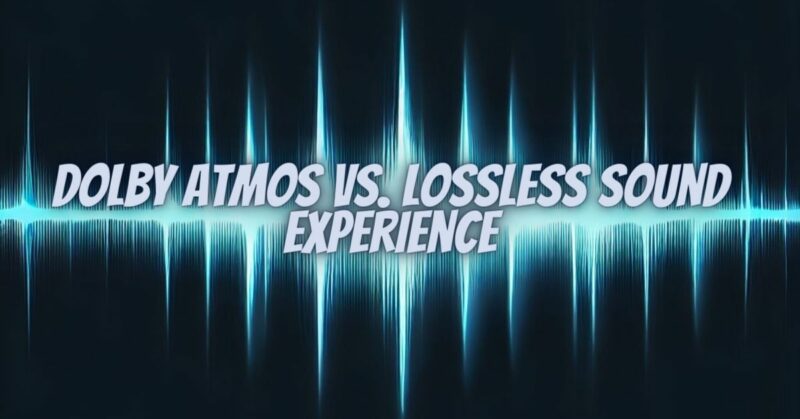In the world of audio fidelity, two prominent contenders, Dolby Atmos and lossless audio, offer distinct sound experiences. Each has its unique strengths and applications. In this article, we’ll compare Dolby Atmos and lossless sound, helping you make an informed choice based on your audio preferences and needs.
Dolby Atmos: Immersive Spatial Audio
Dolby Atmos is a revolutionary audio technology known for its ability to create an immersive three-dimensional sound experience. Here’s what you need to know about Dolby Atmos:
1. Object-Based Audio: Unlike traditional channel-based audio systems, Dolby Atmos uses object-based audio. It allows sound engineers to place audio objects in a three-dimensional space, including overhead. This flexibility creates a truly immersive soundstage.
2. Height Channels: Dolby Atmos systems often incorporate height channels, which means sound can come from above as well as around you. This adds a new dimension to the audio experience, ideal for movies, gaming, and home theater.
3. Content Availability: Dolby Atmos content is prevalent in the film industry, with many theaters and streaming platforms offering movies and TV shows in this format. Some gaming consoles and titles also support Dolby Atmos for an enhanced gaming experience.
4. Home Theater: Dolby Atmos is popular in home theater setups, where it provides a cinematic audio experience. Specialized speakers, including ceiling-mounted or upward-firing units, are used to reproduce height channels.
5. Immersive Sound: Dolby Atmos excels in delivering a captivating and spatial audio experience, making you feel like you’re inside the action.
Lossless Audio: True-to-Source Fidelity
Lossless audio refers to audio formats that preserve every detail of the original recording without any compression. Common formats include FLAC (Free Lossless Audio Codec) and WAV (Waveform Audio File Format). Here’s what you need to know about lossless audio:
1. Uncompromising Fidelity: Lossless audio formats capture and reproduce every nuance of the original recording, ensuring that you hear the music exactly as the artist intended it.
2. High Bit Depth and Sample Rate: Lossless formats often use 24-bit depth and higher sample rates, providing a wider dynamic range and more detailed audio than standard CD quality (16-bit, 44.1 kHz).
3. Music Enthusiasts: Lossless audio is favored by audiophiles and music enthusiasts who prioritize audio quality above all else. It is the go-to format for those seeking the highest level of sound fidelity.
4. Wide Compatibility: Lossless audio formats are widely supported by media players, making it accessible to a broad audience with various playback devices.
5. Music Archiving: Lossless audio is often used for music archiving and preservation, ensuring that the original audio quality is retained for future generations.
Choosing the Right Experience
Choosing between Dolby Atmos and lossless audio comes down to your audio priorities and usage scenarios:
1. Immersive Experience: If you seek an immersive and spatial audio experience for movies, gaming, or home theater, Dolby Atmos is the clear choice. It excels in creating a captivating soundscape that surrounds you.
2. Audio Fidelity: For audiophiles and music enthusiasts who prioritize the utmost audio fidelity, lossless audio is the preferred option. It ensures that you hear every detail and nuance in your music collection.
3. Content Type: Consider the type of content you enjoy most. Dolby Atmos is prevalent in movies and gaming, while lossless audio is primarily used for music.
4. Playback Equipment: Ensure that your playback equipment supports your chosen audio format. Dolby Atmos may require specialized home theater systems, while lossless audio is more universally compatible.
5. Personal Preference: Ultimately, the choice depends on your personal audio preferences. Some users may want both Dolby Atmos for immersive entertainment and lossless audio for critical music listening.
Dolby Atmos and lossless audio each offer a unique and valuable sound experience. Dolby Atmos excels in creating immersive, three-dimensional audio environments ideal for movies and gaming. Lossless audio, on the other hand, ensures true-to-source audio fidelity, making it the preferred choice for audiophiles and music enthusiasts. Your choice between the two ultimately depends on your audio priorities, equipment, and the type of content you most enjoy. Both formats have their merits, and they can coexist to provide a diverse range of audio experiences in your life.


